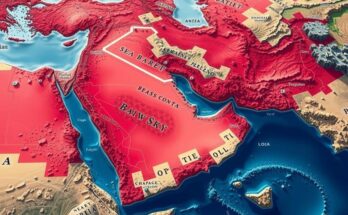Nine months post the Ethiopia-Somaliland memorandum of understanding, regional tensions have intensified, largely due to the involvement of external powers like Egypt and Turkey, which has further complicated relations among Ethiopia, Somalia, and Somaliland. Somalia’s strong rhetoric against Ethiopia, coupled with increased Al-Shabaab activity, poses significant risks to stability in the Horn of Africa. Cooperation among the regional powers remains essential to prevent an escalation of conflict and to effectively counter extremist threats in the region.
Nine months following the memorandum of understanding (MOU) between Ethiopia and Somaliland, the Horn of Africa remains in a precarious state. Initially signed in January, the MOU provided Ethiopian naval forces access to a stretch of Somaliland’s coastline in exchange for considerations regarding Somaliland’s recognition as an independent state. However, this agreement has precipitated heightened tensions across the region, influenced by actions from external powers, particularly Egypt and Turkey. The first major shift occurred when Egypt signed a security agreement with Somalia, encompassing the transfer of military supplies and personnel. This engagement represents a significant deepening of ties between Somalia and Egypt, which has been especially vocal in its support of Somalia’s sovereignty following the MOU. Somali President Hassan Sheikh Mohamud condemned Ethiopia’s actions, characterizing them as an affront to Somalia’s territorial integrity, leading to heightened anti-Ethiopian sentiments within Somalia. Concurrently, Turkey intensified its military presence in Somalia, further complicating the regional dynamics. The ramifications are profound, as Somalia has increasingly turned to other nations for support against what it perceives to be Ethiopian encroachment on its sovereignty. In retaliation to the MOU, President Mohamud declared Ethiopia an enemy, even going so far as to nullify the agreement through legislation. This was accompanied by heightened rhetoric from Somalia, while Ethiopia and Somaliland continued to consolidate their partnership, sharing military training and diplomatic exchanges. Al-Shabaab, the militant group operating in Somalia, has exploited the ensuing instability, enhancing its operational capacity and launching direct attacks against military bases and civilian populations. The ongoing drawdown of the African Union mission, which has historically included a significant Ethiopian military presence, raises concerns about the vacuum this might create for Al-Shabaab to further entrench itself amidst the chaos. In the coming months, the outlook is uncertain as regional militaries might find themselves facing each other, raising the specter of unintentional conflict. Moreover, the ongoing geopolitical rivalry, particularly between Ethiopia and Egypt, could lead to broader regional strife if not addressed through concerted diplomatic means. Despite the current volatility, there exists the possibility for de-escalation and positive developments should the involved parties engage in meaningful dialogue and seek mutual cooperation rather than antagonism. Nevertheless, it remains crucial for regional stakeholders to prioritize stability over discord, given the significant potential for violence fueled by heightened tensions. Ultimately, the nature of cooperation among Ethiopia, Somalia, and Egypt will determine the trajectory of security and stability in the Horn of Africa, with enormous implications for the global community. All actors must recognize the importance of collaboration in mitigating threats posed by extremism and fostering regional development. The dynamics at play underscore how middle-power influences and national agendas can converge, potentially igniting conflicts that have far-reaching consequences.
The Horn of Africa is currently grappling with significant geopolitical tensions rooted in a January 2023 memorandum of understanding (MOU) between Ethiopia and Somaliland. Somaliland, a self-declared independent region of Somalia, entered into the MOU granting Ethiopian naval forces access to its coastline, raising questions about regional sovereignty and stability. In reaction to this agreement, external powers like Egypt and Turkey have also increased their involvement in the region, contributing to an intricate web of alliances and conflicts. Egypt’s involvement stems from historical tensions with Ethiopia over the Nile River and coincides with Somalia’s desperate need for allies against perceived Ethiopian encroachment. The role of Al-Shabaab further complicates matters, as the militant group’s resurgence amidst this geopolitical turmoil threatens the stability of the Horn of Africa, engendering concerns over counterterrorism efforts and the effectiveness of military deployments in the region.
The complex interplay of regional politics following the Ethiopia-Somaliland MOU presents a critical juncture for the Horn of Africa. As external powers like Egypt and Turkey influence the situation, the potential for conflict looms unless diplomatic efforts are prioritized. The escalating threat from Al-Shabaab within this turbulent environment necessitates a cohesive strategy for counterterrorism and greater collaboration among regional powers. The next steps taken by Ethiopia, Somalia, and Egypt will be instrumental in shaping the future stability of the region, emphasizing the urgent need for dialogue, partnership, and compromise to mitigate the risks of escalation and violence.
Original Source: www.atlanticcouncil.org




